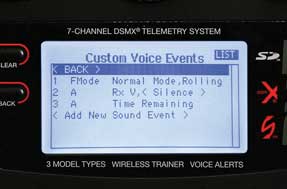

However for F3 and F7 FC’s, the processor has built-in inverters on all of their UART’s, and so you can connect SBUS to any UART you want.

Note that the SBUS signal in Frsky’s receivers is inverted, and therefore (normally) on F1 and F4 FC, there are dedicated SBUS input which indicates there is an inverter in place for the inverted SBUS signal. It supports up to 16 channels using only one signal wire. SBUS signal should be connected to the RX pin of an UART.
#CLEARVIEW SIMULATOR WITH DX7 DSMX SERIAL#
SBUSĪka S.BUS or Serial BUS, is commonly used by Futaba and FrSky. Unlike PPM which is a signal in time domain, serial protocols are completely digital which means they are made up of a bunch of one’s and zero’s.Īs the name suggests, serial protocols require a serial port on the flight controller (aka UART).

So typically, you would only need to connect the ground, power and signal wires for up to 8 channels.Īs the channel values don’t arrive at the same time, it’s not as accurate or jitter-free as serial communications (which we will cover in a minute).Ī serial protocol is a digital loss-less protocol that uses only 3 wires (signal, power, ground) for multiple channels. The advantage of PPM over PWM is that only one single wire is needed for several channels.

#CLEARVIEW SIMULATOR WITH DX7 DSMX SERIES#
A PPM signal is basically a series of PWM signals sent one after another on the same wire, and modulated differently. And so PPM and SBUS are often preferred over PWM when using an FC, which pass all the channels through a single wire and yet offer the same performance if not better. The downside of this is probably the wiring mess, as you have one servo cable for every channel. Back in the days when there was no flight controller, the receivers were used to control the servos and ESC directly with standard PWM signal. This is the most common and basic radio control protocol. The length of the signal pulse normally varies between 1000µs and 2000µs (micro seconds), with 1000µs being the minimum & 2000µs the maximum. PWM stands for pulse width modulation, the length of the pulse specifies the servo output or throttle position, and therefore it shares characteristics of both digital and analog signals. SPI_RX (universal) – More detail in this article.Some RX protocols are universal and used in receivers from different manufactures, but some can be exclusive to certain brands. The communication between radio receiver and flight controller is wired. The difference is the DSMX signal is able to switch to a new frequency channel in case of cut out within a couple of milliseconds, so in theory you wouldn’t even notice the glitch.ĭSM2 is still a popular technology, if you are away from sources of radio interference (such as WiFi, microwaves, and wireless security cameras), it should work just as well as DSMX, but DSMX for sure is more reliable. This greatly lowers the chance of losing signal, however if both channels becomes unusable you may still lose the connection.ĭSMX was based on and improved from DSM2, which also uses the same encoding scheme. It also finds a backup frequency at start-up in case the primary frequency fails. D4R-II, D8R-II+, V8FR-II, VD5M, etcĪCCESS: Frsky’s latest air protocol, New Frsky Air Protocol – ACCESS Spektrum’s DSM2 and DSMXĭSM2 and DSMX are the two TX protocols used by Spektrum radios.ĭSM2 signal is known to be resistant to noise, interference and other transmitters transmitting on the same frequency. D8: for D- and V-series receivers, e.g.Note that for ACCST, there is the older V1 and the newer V2, and the two are not compatible. Here is a list of common TX protocols:įrsky has two TX protocols, ACCST and ACCESS. Manufacturers all have their own TX protocols, some brands even offer multiple protocols depends on hardware. TX ProtocolsĬommunication between the radio transmitter and receiver is wireless. Some manufacturers might share some TX and RX protocols, but most of the times they use their own protocols. TX Protocols – communication between the radio transmitter (TX) and RX.RX Protocols – communication between the radio receiver (RX) and flight controller (FC).RC protocols can be divided into two groups: They are used in radio communication in our FPV drones, RC planes/wings and other radio controlled vehicles. It’s important that you buy things that are compatible and speak the same language, or they just won’t work. An RC protocol is like a language spoken between components.


 0 kommentar(er)
0 kommentar(er)
